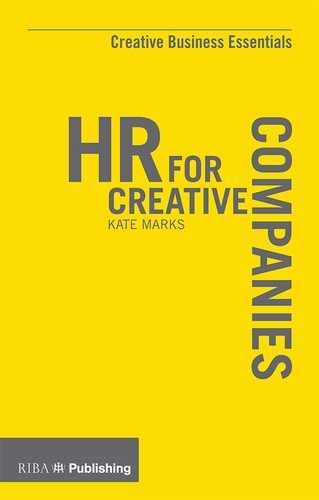04 Reward
REWARD
Now that you’ve enticed the most talented candidates to join your company, you will need to give significant thought to how you are going to reward them for their hard work.
This chapter will focus on:
- > Defining reward and what it means in your company
- > Ideas for financial and non-financial rewards
- > Being clear about what you want to reward.
1. Defining Reward: What It is, or Should Be
We need to begin with an attempt to distinguish between ‘reward’ and ‘recognition’.
To some, the word ‘reward’ automatically means money. But if you ponder on it for a little longer, the reality is rather more complex. There is a plethora of other things that a company can offer to staff which come under the umbrella of ‘reward’. And, let’s face it, if a creative company can come up with innovative solutions for its clients, it should be able to do the same for its people!
Superficially, this topic is most influenced by the dynamics of company size and profitability. There is an expectation that larger companies will have more money to allocate to salaries and remuneration packages. However, this may not always be the case. We can all think of some of the smaller boutique companies who wish to stay that way but still have the ability to pay above-average salaries and other monetary rewards.
Also, as we shall discuss later in this chapter, smaller companies have certain characteristics which give them advantages over larger companies. It’s a question of finding the reward package that suits the individuals in your organisation.
You also need to take into account the increasing focus on the individual in the workplace.
Generic reward systems may be fairer and easier to administrate, but more personal reward systems may be more effective. Given this contradiction, it seems sensible to start with some commonly held ground rules:
- > Not everyone is motivated by money, but if you see your peers earning more, you will be disgruntled.
- > Different rewards will be better received at different stages of your life or career. This is where understanding the individuals in your company will reap its own rewards. Take a look at the demographics of your staff.
- > Don’t just throw money at it. Take into account what other resources you may have available to you. All companies of whatever size and composition will have different things to offer.
- > You need to be fair about what is offered. In simple terms, offer the same benefits in monetary value to all staff or structure your reward

- systems so that it is transparent and different levels are clearly defined and against clear nondiscriminatory criteria. (Remember the legal bit, from Chapter 2?)
- > Try to offer a range of rewards – financial and non-financial. Some examples are given in the table below.
A reward plan in place must be based on research:
- > Benchmark salaries – there are lots of useful websites (see below). Recruitment agencies also have up-to-date information, especially those that specialise in your specific creative area.
- > Look at what your competitors do. Speak to people you know in the industry and ask those who you’ve recently hired about their former employers.
- > Find out what interests your staff have and come up with rewards that will reflect these. They may be work- or home-orientated.
- > Take a look at companies that you admire and what they offer to their
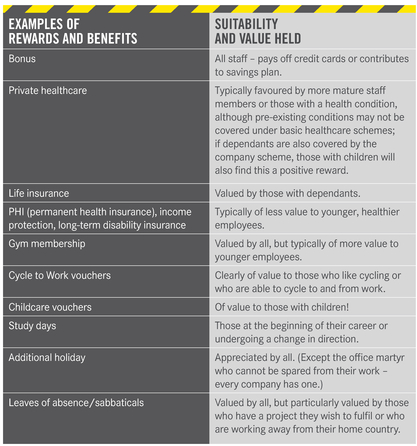
- staff. This may better reflect the culture you are hoping to develop and maintain.
- > Seek input from your staff. You may be aware of their interests, but only they can tell you what their current priorities in life are.
- > Remember that it doesn’t actually have to be financial. Smaller businesses may perhaps have less cash to utilise in this way, but have other things to offer.
![]() www.ribaappointments.com/Salary-Guide.aspx
www.ribaappointments.com/Salary-Guide.aspx
How to Avoid Discrimination in Your Reward System
Length of service: Be careful that this does not inadvertently favour older members of staff. Keep it to rewarding a maximum of ten years’ service.
Part-time staff: Offer proportionate benefits depending on the number of hours worked. If you can’t do so, err on the side of caution and offer the full benefit.
Rewards that recognise out of hours work or extra-curricular activities that only take place on certain days may also be discriminatory against parttime workers and potentially indirectly discriminatory against women, so be careful with this!
Fixed-term staff: Should be offered the same benefits as permanent staff.
Agency workers: May be entitled to some benefits after 12 weeks’ service.
Advanced Reward
Flexible benefits exist but are most common in the larger organisations because they can be complex and take up significant administrative time, or require robust technology standards in the instance of employee selfmanagement. They can also be known as ‘cafeteria benefits’ or ‘flex plans’. I’ve even heard them described as a ‘buffet of benefits’. You get the general idea – there is an element of personal choice on the part of the employee: they can vary their pay and benefits to suit individual personal requirements. In simple terms, this may mean that employees can either retain their existing basic salary while varying the mix or levels of various benefits, or they can adjust their salary up or down by taking fewer or more benefits respectively. So, the dividing line between pay and benefits is less rigid than in standard reward systems.
2. Ideas for Financial and Non-Financial Rewards
To clarify, here is what you must offer your employees:
- > A salary or pay: Financial compensation in return for work. A minimum wage does apply.
- > 28 days’ paid holiday: Most workers who work a five-day week must receive 28 days’ paid annual leave per year. This may include bank holidays. This is linked to the Working Time Directive which also governs hours of work per day and week, rest periods, night working and various other stipulations.
- > Various statutory leaves: These include maternity, paternity, parental, adoption, shared parental, dependant care, and others, and may or may not have statutory pay associated with them.
- > Statutory sick pay: This has pretty specific rules about how it works and it is best to check the government websites for up-to-date information.
- > Time off for jury service and various other commitments: Jury service can be deferred so long as the appropriate procedure is followed. Other commitments include a wide range of activities such as trade union duties, antenatal appointments, and also time off under the Working Time Directive.
You do not have to offer bonuses or other financial rewards, or additional holiday for long service, or additional sick leave.
Financial Rewards
These can be broken down into what we can call traditional and innovative.
There is a school of thought that it should be reward enough to work in an environment that enables you to express your creativity. It is almost as if creativity is a calling or vocation. The old-fashioned image of a painter slaving away in his garret comes to mind.
The current reality is different. Creative companies do not have to sacrifice
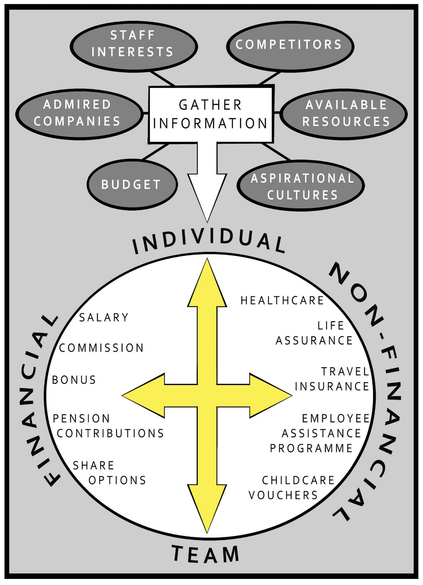
commerciality to succeed; nor does commercial success mean that creativity needs to be compromised.
Part of this development is a recognition that talent has a value. If you do not offer appropriate rewards you will either not attract people in the first place or you will eventually lose the people that you already have.
How you address this requires a basic understanding of reward and how it works.
Let’s define reward, then, as the tangible benefits that your staff receive in return for their work for your organisation. This can be made up from different building blocks, as follows.
Basic salary: This is the guaranteed ‘take home pay’. It is written in the offer letter or contract of employment or whatever other means you have used. It is also the means by which external bodies such as banks and building societies will determine the income of an individual.
Additional variable or nonguaranteed monetary income: There are common examples of this, but they are perhaps less widely explored in creative companies than in other industry sectors:
- > Overtime: It is not unusual to see clauses in contracts of employment that say something along the lines of ‘It is expected that you will work such necessary reasonable additional hours to complete your tasks without additional remuneration’. In essence, you need to finish the work we expect of you regardless of how long it takes and without any extra pay. This goes back to the idea of creativity as a calling – apparently, you won’t mind labouring away for twelve hours a day for a low salary because you will have the personal joy of having created a … building, interior space, piece of music, computer game, short story … just fill in the blanks. You can make all sorts of rules about how you’ll pay overtime, if you choose to pay it. It is rare to see use of a simple hourly rate multiple based on annual salary (the sort of arrangement that seems to be the norm when you call out a plumber for an emergency or at the weekend). More likely, you could have an arrangement that pays only after a certain number of hours per day have been worked. The main point is to have some kind of structure and stick to it, to avoid favouritism and inconsistency.
- > Bonus: Occasionally, creative companies will pay a bonus. The most common timeframe for this would be annually. Its payment will obviously be based upon what money is available. The amount may vary, but should be based on some equitable structure – a percentage of salary perhaps. And if you do pay bonuses, be sure to be on firm ground if you choose not to pay bonuses to some people. Can you show an objective reason for doing so? Make certain you have documented any failure to achieve targets or any performance issues. See Chapter 7 for more on performance management.
- > Share options/profit sharing: This used to be the domain of more senior staff, but is increasingly used to form a more inclusive reward structure throughout the company. Smaller organisations may dismiss this idea thinking it is perhaps better suited to larger organisations, but I would urge you to seek financial advice about it since it is a great way of engaging your staff and making them feel genuinely a part of the business and its future.
- > Commission: It is rare for a commission structure to be in place for the majority of staff in a creative company, but worth mentioning for the exceptions. For example, a commission structure may be applied to someone charged with obtaining new business. Typically they may receive a lower basic salary with the opportunity for higher monetary gain if they reach certain new business targets. You need to be aware of the likelihood of challenge if paying commission in addition to a regular salary to only a few staff members – you may find yourself with a revolt on your hands from those who say it’s unfair on those who don’t have the opportunity to gain commission.
Pension/retirement planning: If you have managed to avoid hearing about auto-enrolment – even if you have no idea what it is – you must have been living in a cave since the start of the 2010s. Basically under the Pensions Act 2008, every employer, however small, needs to make pension contributions for their employees. The process of auto-enrolment is, as it suggests, automatic. Every employee will be automatically enrolled into their employer’s pension scheme upon the first day of their employment. Setting up a scheme is a specialist area and you should seek advice from an independent financial adviser sooner rather than later. This process takes longer than a few days or weeks to set up. Suffice to say, it will involve internal administration time and is therefore a cost. In addition, you will have to make pension contributions as an employer.
Standard benefits: As it suggests these are put in place for all staff members unless they specifically request not to be included. This happens occasionally if someone feels any tax burden may be too great or perhaps they prefer to support the NHS rather than private healthcare.
Options include:
- > Private healthcare – whether just for the employee or for family and dependants too
- > Life assurance – multiple of salary given on death may vary according to seniority
- >> Travel insurance – especially if employee travels regularly for work, could add family as an additional benefit
- > Employee assistance programme (EAP) – a reasonably priced option providing a wide range of support services from counselling to legal and financial advice
- > Concierge services – OK, so this isn’t very common and can be quite expensive, but it’s a great idea. Someone to wait in for deliveries, or for tradesmen, or to do your shopping, or any amount of other services. May be provided alongside an EAP.
Flexible benefits: These are available for all staff members, but they should actively opt to take them up if they wish to do so. Obviously, for example, childcare vouchers will not be of interest to everyone:
- > Childcare vouchers – a government scheme aimed to save you tax on the cost of childcare
- > Cycle to Work scheme – another government scheme enabling employers to loan cycles and cyclists’ safety equipment to employees as a tax-free benefit
- > Gym membership – could be paid fully or in part by company
- > Yoga/neck massage/meditation – classes held in office or local venue
- > Various discount ouchers – often employers are able to offer various discounted vouchers for shopping or experiences (they are able to do so on the basis of bulk discounts).
Discretionary benefits: Offered by the employer for specific reasons. These can either be for all staff, teams or individuals.
All staff:
- > Christmas/annual party
- > Annual trip – weekend away to location in the UK or European capital
- > Summer family party – picnic with games or elaborate barbecue with music.
Teams/all staff:
- > Money behind the bar at local pub – always being conscious of not leaving out those who do not feel comfortable in a pub or who don’t drink alcohol
- > Meal at good restaurant
- > Theatre/film
- > Outing to place of interest or exhibition.
Individual:
- > Red letter days/vouchers, perhaps to celebrate landmark birthdays or for length of service
- > Dinner tickets/days out, to reflect a particular success or contribution by an employee, usually to reflect their love of fine dining, or travel, or theatre or whatever
- > Garden centre vouchers/book tokens/spa treatment/personal shopping experience/wine voucher
- > Eurostar/budget airline tickets
- > Luxury weekend in the UK.
Reward in Small Businesses
Just because you don’t have a lot of cash to flash doesn’t mean you can’t reward your loyal and hard-working staff. List what resources you have. For instance, does your work environment lend itself to informal mentoring or coaching; does your project structure lend itself to allowing someone to learn on the job rather than sending them on expensive training courses; can you involve people in an initiative that will enhance your working practices, or involve them in presenting designs or projects, or include them in awards or industry events?
In fact, when you add it all up, you may have certain advantages over your larger competitors (see table opposite).


Never forget the importance of the social aspects of work. A few hundred pounds spent on a meal or company outing will generally be well spent. However, do be sure that you aren’t inadvertently excluding anyone (e.g. if it’s drinks at the pub, is there anyone who would be uncomfortable in a pub or around alcohol?).
Just remember what you can do so much better than many larger organisations:
- > Know your staff
- > Use your advantages: ease of communication, opportunities for inclusion, experience as generalists rather than specialists, learning opportunities through proximity, flexibility of working practices.
3. Being Clear about What You Want to Reward
You are always going to be pulled in at least two different directions when you’re managing people in a creative environment. Creativity suggests flexibility; HR suggests rules and regulations. However, remember that in Chapter 2 when discussing what HR can be to a company, we talked about HR as an enabler? Here’s a pertinent metaphor:
- > HR can provide the trampoline that will enable you to reach ever greater heights of creativity.
Have you ever read Orbiting the Giant Hairball by Gordon MacKenzie? It discusses the possibility that truly creative people can benefit from some element of structure or foundation in order to be so. So, a structure is not all bad, and will also enable you to address more effectively any peoplerelated problems that may arise.
In effect, you need to start with the concept of giving like reward for like roles. If there is any inconsistency or differentiation, you need to have a good reason or reasons for doing so. At the risk of sounding like a broken record, this is where the job description is invaluable. Clearly, people on the same grade or with the same job title may not have exactly the same job description. If they don’t, this is one means of differentiating and perhaps enabling flexibility in pay or reward. However, it is essential to be clear about what is/isn’t subject to reward.
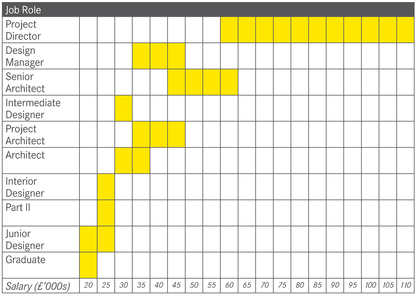
Let’s take the steps in turn:
- Start from the premise that each job title will have a general pay range, as illustrated in the diagram [above]. This is very generic so do not use it as a guide for plotting your salaries! Obviously salaries will be influenced by location, years of experience, and so on, but you will be able to create some general ranges within which to work.
- Examine the related job descriptions for any differences or increased responsibility or tasks. Highlight these against each individual.
- Plot individuals on your salary banding diagram or a similar visual aid. It’s then much easier to see the differences and determine whether they are justified.
- Consider your company culture and what behaviour and attitudes you are trying to engender. Pinpoint examples of behaviour and attitudes that have been demonstrated by your staff (discussed in more detail at the end of this chapter). These are potential reasons for reward above and beyond the basic structure.
You can develop your standard reward structure around salary, financial and non-financial benefits as set down in your contract of employment. You then have the opportunity to offer discretionary rewards to those who have acted above and beyond the role for which they were hired.
What is It That You Want to See from Your Staff?
Some things are quite simple and obvious, and may well have cropped up in the original advertisement for the job. Nevertheless, it is important to consider whether your expectations are reasonable, and what factors are essential.
Timekeeping: This has to be essential, doesn’t it? If someone can’t be on time for work, what hope is there of them being on time with project deadlines?
Reliability: If you never know whether they are going to deliver or what attitude they are going to demonstrate on any given day, how will they conduct themselves in front of clients?
Positive attitude: They may be amazing at their work, but if they are constantly moaning or expressing negative views about the company, their work, you, or the team, could they be trusted to represent the company positively and demonstrate your company’s ethos in front of a client?
Good interpersonal skills: As it used to say on your school report, do they ‘play well with others’? In creative environments, legend has it that everyone is a diva. That’s not to say we haven’t all seen examples of such diva-esque behaviour on occasion, but it is more commonly recognised that selfish, attention-seeking behaviour is not the way to get on in the world, let alone at work.
The above factors should all be essential and, if they are not demonstrated, should be addressed. It is not easy to reduce the basic rewards due to an individual as set out in their contract of employment, but it is possible if you follow due process (see Chapter 7).
However, pause for a moment and remind yourself that what we are considering here is how to reward those who have gone above and beyond your expectations. What have they done? How have they behaved? Why is this good? You need to seek examples of these actions or behaviours so that you can reward them specifically, and hopefully engender a virtuous circle of repeated behaviour or actions. The idea is that if other staff members see these things being rewarded they will do them too.
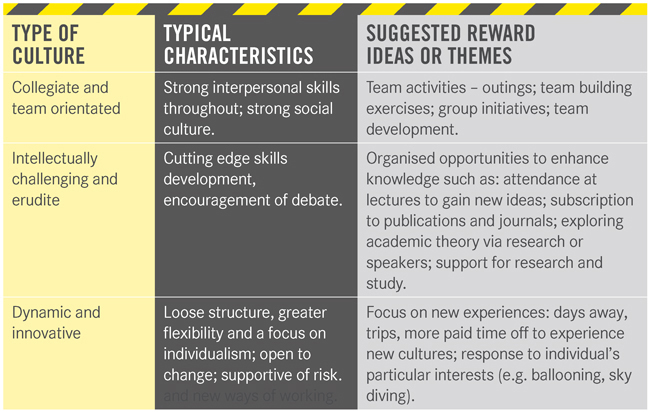
Examples include:
- > Project Project contribution in terms of focused hours or specific skill or additional know-how
- > Mentoring team members and passing on own expertise and knowledge
- > Volunteering for extra-curricular activities such as training or interviewing
- > Contributing towards the general feeling of staff wellbeing – may be positive attitude, or bringing in cakes, or making tea, or supporting a team member who is upset or under pressure.
Some ideas to create a reward structure that echoes your company culture and is unique to you are listed in the table above.
Consider the following situation: your team includes two qualified architects, each with eight years’ experience. One arrives at work on time, gets on with the work, meets deadlines, and produces work of a good standard. The other does exactly the same, but also mentors junior staff during the course of the day, and helps out with interviewing at lunchtimes. So, here you have concrete ways in which you can differentiate between two individuals with a similar job title. One might be at the middle of the pay range; the other higher up.
Also, it may be easy to spot positive things to reward, but you should also be clear about what you don’t want to reward.
Here are some examples of behaviours to be aware of.
Positives:
- > Has a positive attitude to work and colleagues
- > Willingly helps out other team members
- > Occasionally works overtime or longer hours when required
- > Demonstrates good timekeeping
- > Is reliable
- > Is willing to learn.
Negatives:
- > Regularly works all night, seems to enjoy sleeping under desk
- > Always working overtime even though tasks are not onerous
- > Tells you they need help just before missing a deadline
- > Always playing the martyr – ‘I’m fine, I’ll be OK’, when clearly not
- > Never misses a deadline, but runs their team into the ground to do so
- > Exudes negativity and exemplifies the Eeyore syndrome
- > Given to histrionics in the workplace
- > Willing, but always flustered and disorganised, can never find anything at workstation. The untidy desk does not indicate a creative mind in this instance.
On the other hand, you may well be aware of an HR truism that 5 per cent of your employees seem to take up 95 per cent of your management time. Don’t overlook those who keep their head below the parapet when considering rewards.
Some of my examples above may seem a little unfair, but so is penalising someone who can’t work overtime because they have childcare responsibilities, and rewarding someone who does overtime regularly because they are so bad at planning their workload.
Similarly, there is a difference between someone who you know is overloaded with work and has to work overtime while you try to source someone to help, and the person who works overtime because they do not get on with the work when they need to.
We can use overtime as an example to show how you can approach reward.
Summary: Creating a Reward Structure
- > A reward structure does not need to be complicated.
- > The structure needs to be fair and transparent.
- > You need to know what you are rewarding and say so.
- > You do not need a bottomless pit of financial resources. Use whatever resources you have.
- > Be aware of what makes your company unique and focus on that.
- > Know your staff and what kind of rewards they would genuinely value.
- > Seek feedback and constantly review the reward structure to be sure it serves its purpose.
- > And remember that a reward is precisely that – it’s not necessarily what you want but what your employees will appreciate.
